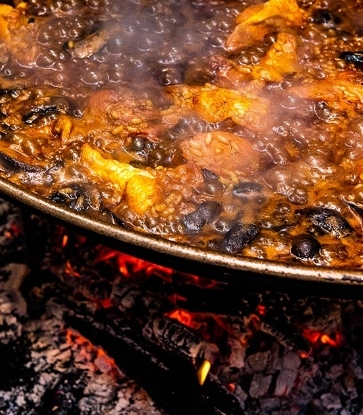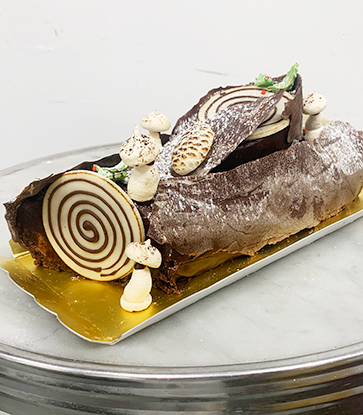“Not familiar with the food of Macau? Not to worry—Fat Rice turns the uninitiated into believers nightly,” state MICHELIN’s troop of anonymous inspectors of Abe Conlon and Adrienne Lo’s adored restaurant in Chicago’s Logan Square.
Since its inception in 2012, the restaurant has grown, occupying the space next door to make way for a bakery and café doling out Portuguese egg tarts, guava and cheese rolls as well as a variety of cookies. The aptly-named Ladies Room lounge makes way for inventive cocktails made with housemade infusions and elixirs.
But the global fare at Fat Rice is truly what you come for; diners can opt from an assortment of dishes including Portuguese sardines with Chinese mustard, pork and ginger dumplings, chili prawns with garlic and fermented black beans and the arroz gordo, aka, fat rice.
Also on the menu is lacassà, a stir-fry comprised of rice noodles, shrimp, char siu por, tofu, garlic chives, omelet and pickled ginger.
“If you had to compare this dish to something, you could say that it’s similar to a pad Thai or Singapore noodle in form, but lighter and milder in flavor, with a garlic punch and sharp ginger achar,” Conlon says in his cookbook, The Adventures of Fat Rice. “The word lacassà always refers to a dish containing rice noodles, and most likely comes from a Cantonese phrase for rain, loc-soei, because the noodles, as they are extruded, resemble pouring rain. Solid technique will create the much-sought-after wok hei that gives this noodle dish its distinct flavor.”
Here’s how to make it at home.

Lacassà (Macanese Rice Vermicelli Stir-Fry)
Adapted from The Adventures of Fat Rice: Recipes from the Chicago Restaurant Inspired by Macau by Abraham Conlon, Adrienne Lo and Hugh Amano, Reprinted with Permission by Ten Speed PressIngredients
2 tablespoons light soy sauce
1 teaspoon kosher salt
1/4 teaspoon freshly ground white pepper
2 teaspoons granulated sugar
2 tablespoons water
3 ounces rice vermicelli
3 tablespoons peanut oil
3 eggs, beaten
1 small yellow onion, cut in julienne
1 carrot, peeled and cut in julienne
4 ounces char siu (Chinese BBQ pork), cut in julienne (about 1 cup)
5 green onions, both white and green parts, shredded
5 ounces medium shrimp, peeled, deveined and split lengthwise
3 cloves garlic, minced
small handful of mung bean sprouts
1/2 teaspoon toasted sesame oil
Ginger achar, cut in julienne (recipe below)
Small handful of chopped fresh cilantro
Method
1. In a small bowl, mix together the soy sauce, salt, white pepper, sugar and water; set aside.
2. Put the noodles in a bowl, cover them with hot water and soak for 2 minutes until soft, or as directed on package. Drain and set aside.
3. Heat a prepared wok over medium heat. Add 2 tablespoons of the peanut oil and carefully swirl around to coat the wok. Add the beaten eggs to the wok and let sit until you start to see a ring of cooked egg on the bottom of the wok, about 5 to 10 seconds. Carefully tilt the wok in a circular motion to coat the sides with egg, approximately 8 inches in diameter. At this point you should be able to flip the egg—give it a quick season with salt and do so. Immediately turn off the heat and, using a wok ladle, fold the egg three times until you have a rectangular omelet of roughly 2 by 8 inches. Transfer to a cutting board, julienne into thin strips, season with salt and set aside.
4. Wipe out the wok and return it to high heat. Add the remaining 1 tablespoon peanut oil and, when smoking, add the onion, carrot, char siu, green onions, shrimp and garlic. Stir-fry for about 1 minute, until the vegetables become vibrant and aromatic and the shrimp starts to turn pink. Add the noodles and continue to stir-fry until all of the ingredients are well distributed among the noodles, about 30 seconds. Then leave the wok alone and let the ingredients just hang for about 30 seconds to let the wok recover heat. Stir-fry for another 30 seconds; at this point the ingredients should be thoroughly softened and the noodles no longer wiry.
5. Drizzle the soy mixture around the wok and stir-fry for about 15 seconds to ensure that the steam generated is being absorbed by the noodles. Add the cooked egg and bean sprouts, drizzle in the sesame oil and stir-fry to incorporate. Transfer to a large serving plate and garnis with the ginger achar and cilantro. Serve immediately.
Ginger Achar
Ingredients
3 ounces fresh ginger, peeled and julienned
1 1/2 teaspoons kosher salt, divided
2 ounces red beets, peeled and coarsely chopped
1/2 cup water
1/2 cup Filipino cane vinegar
1/4 cup granulated sugar
Method
1. Toss the ginger with 3/4 teaspoon salt in a medium bowl and set aside. Put the beets in a blender and set aside. Combine the water, cane vinegar, sugar and remaining 3/4 teaspoon salt in a small saucepan over high heat. Bring to a boil and then pour over the beets. Blend carefully, covering the top of the blender with a towel and cracking the lid slightly to let steam escape safely, until smooth. Strain through a fine-mesh sieve back into the original saucepan and set aside.
2. Pat the ginger dry of excess moisture and place in an appropriately-sized storage container, such as a clean mason jar. Bring the beet liquid to a boil over high heat, cook until reduced by half, then pour over the ginger. Let cool. Use immediately or cover tightly and refrigerate for up to 1 month.
Image by Kathryn M. Sheldon.






















